 Table
of Contents
Table
of Contents
1. What
is PPPop?
2. Requirements and
Installation
3. Quick Start
4. Reference
4.1. Which
PPP Software?
4.2. More
than one Internet Account?
4.3. Menu
by Menu
4.3.1. File Menu
4.3.2. Edit Menu
4.3.3. Special Menu
4.3.4. Timer Menu
4.3.5. Server Menu
4.3.6. Profile Menu
4.3.7. Launcher Menu
4.4. Keyboard
Shortcuts
4.5. Scripting
PPPop
4.6. About
Internet Config
5. Troubles? Questions?
6. PPPop is Shareware:
How to Register
7. Contact Information
Version 2.0, October 1,
1998.
1. What
is PPPop?
 PPPop
is a Macintosh PPP operator application which is useful to anyone who uses
PPP to connect to the Internet.
PPPop
is a Macintosh PPP operator application which is useful to anyone who uses
PPP to connect to the Internet.
PPPop simplifies the process of connecting
and disconnecting; it provides a visual indication of your connection status;
it enables you to quickly change dialup numbers and Internet accounts;
it keeps track of online time, and it launches applications and URLs.
 When
you use PPPop, you don't need to use another control panel to open or close
a connection. Just click on PPPop's button. The arrow on the
button shows the current state of PPP: up or down.
When
you use PPPop, you don't need to use another control panel to open or close
a connection. Just click on PPPop's button. The arrow on the
button shows the current state of PPP: up or down.
PPPop displays your time online in a separate
little window. When a connection opens or closes, PPPop will play
a distinctive sound. When you connect, PPPop can automatically run
other applications or scripts, or open URLs. Likewise, when you disconnect,
PPPop can close your applications and run cleanup scripts for you.
PPPop has many more conveniences including
session logging, time limits, separate settings for different accounts,
and selection of PPP, TCP/IP, and Modem settings directly from a menu.
PPPop is also scriptable.
 PPPop
is aware of Mac OS 8.5 Appearance Themes as well as Kaleidoscope Color
Schemes.
PPPop
is aware of Mac OS 8.5 Appearance Themes as well as Kaleidoscope Color
Schemes.
PPPop is designed to be fun to use and nice
to look at. It is a Macintosh only application.
Back to Table of Contents
2. Requirements
and Installation
Requirements
• Hardware: Macintosh computer with
a PowerPC CPU. This version of PPPop will not run on a 68k Macintosh.
(An older 68k-compatible version is still available via PPPop's
Web page.) RAM requirement 600k, 400k with virtual memory.
• System Software: OS 7.1 or
later with Appearance extension 1.0.3. OS 8 or later recommended.
PPPop is optimized for OS 8.5.
• Network: OpenTransport or
MacTCP with compatible PPP software. PPPop has been tested with the
following PPP software:
OpenTransport/PPP
Apple Remote Access
MacPPP
2.0.1
MacPPP 2.5.1 (from Apple Internet Connection
Kit, version 1.2)
FreePPP
1.0.5
FreePPP
2.5v3
FreePPP
2.6.2
Recommended
Additional Software
• Internet Config 2.0 is very strongly
recommended. With Internet Config 2.0, you can use PPPop to open
URL items from the Launcher. Mac OS 8.5 comes with Apple's own version
of Internet Config 2.0. You do not need to install it when you use
OS 8.5.
The latest version is available from Stairways.
.
• Apple Location Manager. The
version for desktop Macs is included with OS 8.1 and later. You can
also download it from Apple. Use the Search function.
Installation
PPPop does not use an installer. You can
run it directly from its folder as distributed. PPPop will create
a "PPPop" folder in your System Preferences folder. This folder will
contain your PPPop Profiles and log files.
If you use Apple Location Manager, drag the
"PPPop" Location Manager module onto your System folder. The System
will place it in your "Location Manager Modules" folder. The next
time you restart your computer, Location Manager will recognize the PPPop
module. See Section 4.3.6 ("Profiles") for
more information about using PPPop with Location Manager.
If you want PPPop on the Apple Menu,
I recommend that you place an alias to the application there.
If you want PPPop in your Startup Items
folder, you probably want it to go to the background after it starts.
To make PPPop go to the background you should either place PPPop itself
in that folder, or place an alias there and check the "Return to Finder"
option in PPPop's Special menu.
Incompatibilities
There are reports that it works variably with
MacPPP 2.2.0. PPPop does not work with InterSLIP or with other proprietary
PPP software, such as Sonic PPP, or FreePPP 2.5.1-2.5.5. Support
for scriptable PPP software, such as Sagem ISDN PPP, Vicom SurfDoubler,
and NTS PPP is planned for the future. You cannot use them with this
version of PPPop2.
PPPop is an application. It is not an
extension. It does not patch or alter your System.
Back to Table of Contents
3.
Quick Start
1. Arrange the Windows
 The
first thing to do after launching PPPop is to move the Button window to
a good spot on your screen. You may also wish to change its size
and eliminate the window's title bar. (See Special menu.)
Once you eliminate the title bar, you can still move the window by holding
down the Command key while dragging it. If you make the window "float",
it will always be visible on top of other program's windows.
The
first thing to do after launching PPPop is to move the Button window to
a good spot on your screen. You may also wish to change its size
and eliminate the window's title bar. (See Special menu.)
Once you eliminate the title bar, you can still move the window by holding
down the Command key while dragging it. If you make the window "float",
it will always be visible on top of other program's windows.
Tip:
You can hide/show floating windows by pressing Command-Escape from within
any program.
Next you should adjust the location of the Timer
window. You can move it by holding down the Command key while dragging
it. If you select "Auto Position Timer" from the Timer menu, the
Timer window will move along with the Button. You can also select
a specific font, font size, and style.
To cycle the Timer through session time,
daily time, and cumulative time press the space bar or click on the Timer
window.
To set warning time limits and to make the
total time automatically reset on a specific day of the month, open the
Timer Setup dialog.
Important:
The timer and log file do not keep time if PPPop is not running!
.
2. Set up the Launcher
Here is an example of how to set up Launcher
items:
Let's set up Eudora as our email application.
We'd like it to start up automatically whenever we connect, and we also
want a command key shortcut for this mail function.
First open "Launcher Setup..."
from the Launcher menu.
Click "New". The Launcher Item Editor
will appear.
Now enter a label, "Mail" for instance.
Tab to the next field and enter "M" to assign
Command-M to this Launcher item.
Next, press "Set..." to pick the application
for PPPop to launch. Better yet - in the case of Eudora and other
applications which can use different settings files - select your "Eudora
Settings" file.
Finally, check "Launch After Opening PPP Connection".
Press "OK". |
|
| Next, let's add a web
browser Launcher item using Netscape.
Click "New" again.
Enter the label "Web" and a command key shortcut
"W".
"Set..." the application to Netscape or one
if its settings files in the "Netscape Users" folder.
Let's say we don't want the browser to start
automatically with every connection, but we do want Netscape to quit automatically
when we close the connection: check "Kill Before Closing PPP Connection". |
|
| Finally, add a Launcher
item for a frequently visited web page, for example "MacNN".
Go to the Launcher Item Editor, enter the
label "MacNN".
No command key for this one.
In the "Object" box, click the URL radio button.
Enter the URL which Internet Config 2.0 will
then send to your web browser: "http://macnn.com/". |
|
Back in the Launcher Setup screen, click
"OK", and then take a look at the Launcher menu.
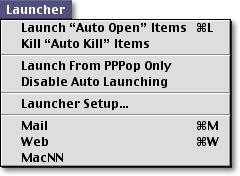 |
Our three items have
been added to the menu: "Mail", "Web", and "MacNN".
When you select one of them from this menu,
PPPop will go online and then launch the item.
Tip:
To conveniently launch applications and URLs from PPPop use a utility such
as UltraLaunch to set a "hot key" for PPPop. You can then navigate
with just the keyboard: press the hot key to bring PPPop to the front and
within PPPop start any Launcher item with the command key you assigned
to it.
|
3. Connect
To connect, all you have to do is click the Button.
If you are often getting busy signals with
one dial-in number, you can set up different PPP configurations which use
different dial-in numbers (if available). You then can easily switch
to another number with PPPop's Server menu. For more information
regarding this see the Reference section on Multiple
Dialup Numbers below.
For more Help...
Aside from this Reference, there is online help
available via the Help menu.
Also all menus and dialogs have balloon help.
Tip:
With an extended keyboard, you can use the "Help" key to turn balloons
on and off.
This should be enough to get you started
with PPPop.
If you have several Internet accounts, or
several users share your computer, or if you work at different locations,
you should look at the PPPop Reference sections regarding the Server
menu, Profiles, and Location
Manager.
Back to Table of Contents
4. Reference
4.1. Which PPP Software?
4.2. More than
one Internet Account?
4.3. Menu by Menu
4.3.1.
File Menu
4.3.2.
Edit Menu
4.3.3.
Special Menu
4.3.4.
Timer Menu
4.3.5.
Server Menu
4.3.6.
Profile Menu
4.3.7.
Launcher Menu
4.4. Keyboard Shortcuts
4.5. Scripting PPPop
4.6. About Internet
Config
Back to Table of Contents
4.1.
Which PPP Software?
OpenTransport/PPP and Apple Remote Access
PPPop is fully functional with current versions
of OT/PPP and ARA. Once you have set up your TCP/IP configurations
and PPP configurations, you can switch among them from PPPop without opening
their control panels.
OT/PPP and ARA are automatically installed
with new System installations.
FreePPP
PPPop works well with FreePPP 2.6.
However, no Dialing icon will appear on PPPop's button while you are connecting.
PPPop will operate most earlier versions
of FreePPP too (v1.0.5 and 2.5), but the Connection Status window and Dialing
icon will not be available with them.
MacPPP
PPPop will operate MacPPP, but the Connection
Status window and Dialing icon will not be available.
IPNetRouter
Some users of IPNetRouter have found that
they must run an application to open a connection. Thereafter, PPPop
can monitor the connection and close it. In the Special menu, select
"Connect via Application..." and choose the application you want PPPop
to run when you click the button to open a connection.
More than one PPP software
With Open Transport, you can have more than one
PPP software installed. From the TCP/IP control panel, you can then
select the PPP you wish to use. (I think the most efficient way to
do this is to set up a separate TCP/IP configuration for each type of PPP.)
PPPop can detect any changes in your selection of PPP software on-the-fly.
There is no need to restart PPPop.
I recommend that you only have one type of
PPP installed unless you are actually using more than one. PPPop,
and perhaps other applications, will work a little faster.
Back to Table of Contents
4.2
More than one Internet Account?
Multiple Dialup Numbers
Your Internet account may be accessible via many
telephone numbers. If you experience busy signals, get poor modem
speeds, or want to call in from different locations, you may wish to set
up more than one dialup number.
To do this, open your PPP setup control panel
or application (for example "Remote Access", "PPP", or "FreePPP Setup")
and begin by duplicating the PPP configuration of your main dialup number.
(In "Remote Access", for example, you need to open "Configurations..."
from the File menu, select your main PPP configuration there and click
"Duplicate...".) In the duplicated configuration, change the telephone
number and give the new PPP configuration a descriptive name. Save
your changes and quit your PPP setup control panel or application.
PPPop will add the new PPP configuration(s)
to the Server menu. You can now switch among them directly from the
Server menu.
Used in this way, all calls with PPPop will
use the same Timer, Launcher items, and other options. To use separate
settings for an Internet account, you should set up PPPop
Profiles.
Multiple Internet Service
Providers
If you use more than one ISP, you usually need
to change a lot of things to switch between them. Fortunately, with
PPPop the switch-over now becomes very easy to do once you have set it
up:
To begin, open the TCP/IP control panel, open
"Configuration..." (Command-K) in the File menu and create a new configuration
for each additional ISP. (You will have to duplicate an existing
configuration to create a new one.) Enter the DNS addresses as supplied
by your ISP. Save the configuration with a descriptive name and quit
the control panel.
Next, open the Remote Access or PPP setup
control panel/application and here too create a new PPP configuration for
each additional ISP. The PPP configuration is where you enter the
telephone number, account ID, passwords, and connection methods for the
ISP. Save the new PPP configurations.
At this point, you can already use PPPop to
switch between ISPs by choosing the proper TCP/IP and PPP configuration
from PPPop's Server menu.
However, you will also notice a serious problem:
many Internet applications won't work properly because they use
their own settings - which haven't been changed. Your email program
or web browser will probably still try to use the other ISP. NewsWatcher
may insist on rebuilding the entire newsgroup list. You may find
that connections are refused and passwords re-requested. You might
even end up using the other ISP's servers. And PPPop, so far, will
only use one set of timers and Launcher items for all of your ISPs.
To switch problem-free between ISPs, use the
recommended additional software:
• Apple Location Manager
• Internet Config 2.0 or later.
• Location Modules for Internet Config
2.0 and PPPop.
And - in outline - use this procedure:
-
In PPPop, create a new "Profile"
for each ISP.
-
In Internet Config 2.0 (or the Internet control
panel if you use Mac OS 8.5), create a new "Set" for each ISP.
-
In Location Manager, create a new "Location"
for each ISP. Tell Location Manager to automatically switch TCP/IP
configuration, PPP configuration, PPPop Profile, and Internet Config Set
for each ISP when you change Locations.
-
In PPPop set up Launcher items to open your Internet
applications from their preferences, settings or user files rather than
launching these application directly.
-
Use Location Manager to do the switch-over.
Your Internet applications may not respond correctly
to a change in Internet Config settings. You might have to quit and
relaunch them. Many applications will do a better job of switching
ISPs if you save a separate preferences file for each ISP. (Eudora,
NewsWatcher, and Netscape support this, among others.) For each PPPop
Profile, you would then set up PPPop's Launcher
to use the specific settings file which goes with each ISP.
For additional information read the chapter
about the Server Menu.
Using Location Manager to Manage Multiple Internet
Service Providers
-
Install Location Manager and its Control Strip
from your Mac OS CD.
Place the PPPop and Internet Config 2.0 Location
modules in the "Location Manager Modules" folder which is in your System
Extensions folder. (You will need to restart your computer before
Location Manager will recognize these modules.)
.
-
Open Location Manager. Select or create
a Location. In the scrolling list of available modules, check:
• AppleTalk & TCP/IP
• Internet Config
• PPPop
• Remote Access
.
For each of these items, click the "Edit"
button to select the configuration you will use with the ISP.
-
Repeat this setup procedure for each Location.
Back to Table of Contents
4.3
Menu by Menu
4.3.1. File Menu
4.3.2. Edit Menu
4.3.3. Special Menu
4.3.4. Timer Menu
4.3.5. Server Menu
4.3.6. Profile Menu
4.3.7. Launcher Menu
Don't forget balloon help for assistance
with the menus!
Tip:
With an extended keyboard, you can use the "Help" key to turn balloons
on and off.
Back to Table of Contents
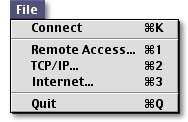 4.3.1.
File Menu
4.3.1.
File Menu
Remote Access... (or PPP...)
Opens your Remote Access or PPP configuration
control panel or program. This may be Config PPP, FreePPP Setup,
or PPP - depending upon which driver is active.
TCP/IP... (or MacTCP...)
Opens your TCP/IP control panel. If you
have MacTCP installed instead of Open Transport, this menu item is MacTCP...
Internet... (or Internet Config...)
Note:
Mac OS 8.5 comes with Apple's own version of Internet Config 2.0.
You do not need to install it when you use OS 8.5.
If you have Internet Config 2.0 installed, this
menu item opens the Internet Config application (or the Internet control
panel with OS 8.5) so you can edit your Internet preferences.
PPPop will use the Internet
Config database of helper applications to parse URL items in the Launcher.
As of this writing, the current version of
Internet Config is 2.0. (Click
here to download Internet Config)
Quit
If you Quit PPPop while a connection is open,
PPPop will close the connection automatically. If you do not
want that, enable Connection Warning on Quit in
the Special menu. That way you can quit PPPop without closing the
open PPP connection. But beware: if PPPop is not running when a connection
is open, the timer and log file will not reflect your actual usage.
Back to Menus
Back to Table of Contents
4.3.2.
Edit Menu
Copy (or Copy IP Address)
When you are online and the Button window or
Timer window is in front, the "Copy" item changes to "Copy IP Address".
This feature comes in handy if you need to enter your current IP Address
into another program, such as a network game or a telephony program.
Bring the Button window or Timer window in front and select "Copy IP Address".
Then in the other program, click wherever you need to enter your IP address
and do a simple "Paste". When a dialog is in front, the menu item
returns to the standard "Copy" function.
Note:
The IP address is only available when you are online, even if you have
a static IP address.
Back to Menus
Back to Table of Contents
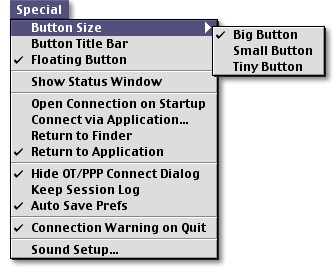 4.3.3.
Special Menu
4.3.3.
Special Menu
Button Size
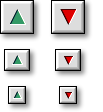 Select a PPP operator button size:
Select a PPP operator button size:
Big: 32 x 32 pixels.
Small: 24 x 20 pixels.
Tiny: 16 x 16 pixels.
With all choices, the green up arrow
means the connection is now open. The red down arrow means the connection
is now closed. Clicking on the button will reverse the state of the
connection.
 With OT/PPP, a dialing icon appears when you click the button to open a
connection. You can click the button to cancel the process.
After that it may take a few seconds for OT/PPP to reset before you can
try again.
With OT/PPP, a dialing icon appears when you click the button to open a
connection. You can click the button to cancel the process.
After that it may take a few seconds for OT/PPP to reset before you can
try again.
Note:
When OT/PPP's own connection dialog window is visible, PPPop may not be
able to display the dialing icon.
However, OT/PPP's connection dialog will
serve the same purpose.
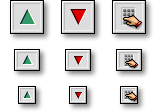 When
PPPop becomes a background application, the button icon gets a distinctive
dimmed/recessed appearance. This should allow you to quickly recognize
if PPPop is the active application.
When
PPPop becomes a background application, the button icon gets a distinctive
dimmed/recessed appearance. This should allow you to quickly recognize
if PPPop is the active application.
Button Title Bar
As shown in above examples, you can get rid of
the window's title bar altogether. You can still reposition the window
by command-dragging it: keep the Command key held down while clicking in
the window and dragging it, then release the Command key.
Floating Button
You can choose to make the Button window a global
floating window. Such windows will always be in front of all windows
of any application, even when PPPop is not the active application.
Global floating windows do not disappear when
you select "Hide Others" from the Mac OS's application menu. To hide/show
all floating windows, press Command-Escape.
Important:
There is a bug in the current implementation of floating windows: if you
double-click a floating window, the program may crash! If you find
yourself frequently double-clicking the Button window and crashing, you
may want to make only the Timer window floating.
Show Status Window
The Connection Status window is a small utility
window which displays some information about the PPP connection: your computer's
IP address, the remote IP address, total number of bytes sent and received
since connecting, and bytes per second data rates.
The information in this window is obtained
directly from the PPP software. Therefore data rates can fluctuate
wildly, because they reflect the data rate of Open Transport, not of your
modem or network.
The Connection Status window is only available
for OT/PPP, Remote Access, and FreePPP 2.6.
If you require detailed connection information,
consider using an application like TCPWatcher or IPNetMonitor, or use the
Information window in FreePPP.
Open Connection on Startup
When PPPop is launched, it will immediately open
a PPP connection.
Connect via Application...
You may have a setup which requires certain actions
to be taken before a connection is opened. In this case, when
you click the Button to connect, PPPop can run an application to manage
the connection.
Apparently, some configurations of IPNetRouter
change TCP/IP configurations such that PPPop cannot open a connection.
(It can still monitor and close the connection.) You can use this
option to make PPPop run the IPNetRouter application when you want to connect.
Return to Finder
After PPPop opens or closes a connection, it
will activate the Finder and go to the background. If checked, PPPop
will also go to the background after it starts up. This is useful
if you place an alias to PPPop in your Startup Items folder.
Return to Application
A "boomerang" option: after PPPop opens or closes
a connection, it will (re)activate the application you were last using
before you switched to PPPop. This option is intended for users who
often open and close connections to save online time, e.g. to read long
text passages offline.
Notes:
This option and "Return to Finder" are mutually exclusive. Enabling
one will automatically disable the other.
If PPPop is "auto launching" applications,
the last application launched is always active, overriding the "Return
to Application" function.
Launching any application from within PPPop
overrides this option.
Hide OT/PPP Connect Dialog
If checked (recommended!), OT/PPP will not show
any progress dialogs while a connection opens or closes. Error messages
from OT/PPP will still appear. If you want to cancel the dialup,
click PPPop's button.
Note:
This option is only in effect when operating PPP from PPPop. It will
be ignored when you use the PPP control panel, a control strip, or FreePPP
Menu.
Keep Session Log
PPPop can keep a simple log file. On opening
a connection, it writes a line with the date, time, and server. On
closing a connection, it writes a line with the date, time, server, session
time, and total time. Whenever the day changes, it writes the daily
time.
The log is a text file with fields delimited
by tabs. (The log doesn't look too good in SimpleText because SimpleText
doesn't do tabs. Use a text editor with tabs set to 14 or more for
better results.)
The log file may be imported into a spreadsheet
for further computations.
Log Example:
Date Time
Server Status Session
Cumulative Daily
8/7/98 7:00:46 AM
Delta Prime OPEN
8/7/98 7:01:49 AM
Delta Prime CLOSE 00:01:03 010:04:13
8/7/98 5:00:51 PM
Delta Prime OPEN
8/7/98 5:20:32 PM
Delta Prime CLOSE 00:19:41 010:23:54
8/7/98
00:20:44
8/8/98 9:50:30 AM
Xenon OPEN
8/8/98 10:18:45 AM Xenon
CLOSE 00:28:15 010:52:09
(...)
Where is the log file?
PPPop creates the log file in the System Folder
-> Preferences -> PPPop folder and names it after the Profile you are using.
For example, if your current Profile is called "Alastor Prime", the log
file will be named "Alastor Prime Log". Once the log is created by
PPPop, you can move it somewhere else on your disk if you wish.
Tip:
Use Internet Config to set a default text editor, e.g. BBEdit. PPPop
will then create the log as a file of your default editor rather than SimpleText.
Notes: The log
function won't work if PPPop is not running while you are connected.
If you import the log into a spreadsheet
program, be sure to "Save As..." with a different name. PPPop will
not be able to add new entries to a non-standard text file.
Auto Save Prefs
When checked, PPPop will automatically save its
preferences file (which includes all the Timer data) once per minute.
This will minimize data loss in the event of a crash.
Connection Warning on
Quit
If this item is checked, and a PPP connection
is open while you quit PPPop, a warning alert will appear giving you the
option of cancelling, closing the connection and then quitting, or just
quitting. If this item is unchecked, however, PPPop will just quit
without a warning alert. You may wish to disable the warning if you
want to just shut down your Mac when you are finished, or if you are scripting
PPPop.
Note:
The timer and the session log will no longer reflect your actual usage
if a connection is open while PPPop is not running.
Sound Setup...
Brings up the "Sound Setup" dialog for setting
sound options:
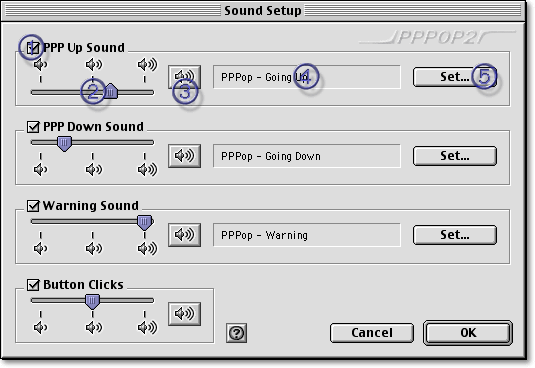
PPPop will make a clicking sound when you
click on the connection button and will play a sound file when a connection
opens or closes or when a time limit is reached. You can individually
set the playback volume for each of these four sounds.
If the group checkbox (1)
is not checked, the sound will not play regardless of the volume setting.
Adjust the Volume slider (2)
to the right to play the sound louder. After any volume adjustment,
the sound will automatically play so you can hear the new setting.
To test the sound, click the Play button (3).
(4) shows
the current sound file name. If PPPop cannot find a previously selected
sound file, you will hear a short "thwok" when you click the Play button.
By default, PPPop will look in the "PPPop
Sounds" folder in its own folder for the following three sound files:
• "PPPop - Going Up"
• "PPPop - Going Down"
• "PPPop - Warning"
To use different sounds, click the Set button
(5) and pick a new sound file.
PPPop can use any System 7 sound file. Those are the ones with a
little speaker on the icon and which play when double-clicked. (Their
Finder type is "sfil"). PPPop will play stereo sounds if you have
them. If you later move a selected sound file to another folder,
PPPop should still be able to find it.
Sounds play asynchronously, meaning that PPPop
will not pause in its operation to wait for the sound to finish playing.
So go ahead and use big 16-bit stereo sounds! A good source for sounds
is Clixsounds. But you can
also look in Info-Mac.
Notes:
The maximum volume is affected by the volume in the System's Sound control
panel. PPPop's volume settings range from 0 to 200% of this "master
volume".
To accommodate large sound files, PPPop will
attempt to use "temporary memory". As long as you have enough free
RAM, you should be able to use megabyte sized sound files without having
to increase PPPop's memory partition with the Get Info dialog.
Back to Menus
Back to Table of Contents
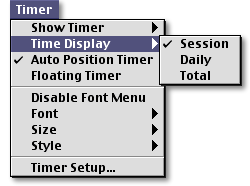 4.3.4.
Timer Menu
4.3.4.
Timer Menu
Show Timer
Select between "Always", "Only When Connected"
and "Never". Even if the Timer window is hidden, timing will continue.
Time Display
Select session time, daily time, or total time
to display. You can rotate among these three selections directly
from the keyboard by pressing tab, Shift-tab, or space.
Clicking on the Timer window will also rotate the displayed time.
Each of the three times has a different format
so that you know at a glance which time you are seeing:
Session Time

HH:MM:SS |
Daily Time

HH:MM |
Total Time

HHH:MM |
Auto Position Timer
If you don't intend to position the Timer and
Button windows independently of each other, it's probably a good idea to
check this menu item. If checked, the Timer window will always stay
attached to the Button window when you move the Button window - positioned
just below it.
Floating Timer
Independent of the Button window you can also
choose to make the Timer window a global floating window. Such windows
will always be in front of all windows of any application.
Global floating windows do not disappear when
you select "Hide Others" from the Mac OS's application menu. To hide
or show a floating window, press Command-Escape.
Important:
There is a bug in the current implementation of floating windows: if you
double-click a floating window, the program may crash! If you find
yourself frequently double-clicking the Button window and crashing, you
may want to make only the Timer window floating.
Disable Font Menu
If you have a large number of fonts installed,
PPPop may take a long time to launch while the Font menu is loading.
Once you settle on a timer font, check this option. It could speed
up PPPop's launch time considerably. You can re-enable the Font menu
at any time by unchecking this item. It might take a few seconds
then until all fonts are loaded.
Font, Size and Style
 You can customize the Timer window by using any font, size and style you
like. The Timer window resizes to accommodate your choice.
Depending on the font, however, some choices might not center properly
or might otherwise look strange.
You can customize the Timer window by using any font, size and style you
like. The Timer window resizes to accommodate your choice.
Depending on the font, however, some choices might not center properly
or might otherwise look strange.
Have fun.
Timer Setup...
Brings up the "Timer Setup" dialog for setting
timer options:

Manually enter the total time (1).
Set the day of the month (2) for the
total time to reset automatically.
The Timer can round up the connection time
by an optional number of minutes each time a connection is closed (3).
Most Internet Service Providers which keep track of your online time round
up to the next whole minute for billing purposes. I have been told
that some round to the next 10 or even 15 minutes! By setting the
"round up" time, you can avoid large discrepancies between your actual
time online and the amount you are billed for.
Set warning time limits for session (4),
daily (5), and total time (6).
Set the method of notification (7):
a sound, and/or an alert, and/or the connection is cut off immediately.
The last option may sound drastic, but it could protect you from an unattended
connection: maybe you (or your kids!) left the room with an open connection
and forgot to come back, or a connection opened by itself in the middle
of the night, etc.
Back to Menus
Back to Table of Contents
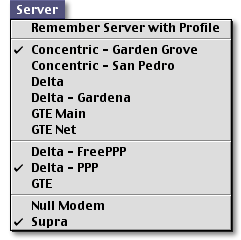 4.3.5.
Server Menu
4.3.5.
Server Menu
PPPop creates a menu with a list of PPP configurations
it finds in the PPP Preferences file maintained by Config PPP (or FreePPP
Setup) or the Remote Access Connections file maintained by OT/PPP.
Underneath the PPP configurations PPPop will
list your TCP/IP configurations if you have more than one of them.
And if you use OT/PPP and have more than one
modem configuration, PPPop will list them too below your TCP/IP configurations.
You can directly select any PPP, TCP/IP or
modem configuration from PPPop's Server menu - no need to open another
control panel. To avoid conflicts, the Server menu is disabled when
a PPP connection is open or when your PPP setup control panel is open.
Typically, you would create a PPP configuration
for each dialup number available to you. Several of these would be
associated with the TCP/IP configuration of one Internet Service Provider.
If you change TCP/IP configurations, you would usually need to change the
PPP configuration also. I suggest that you create your configurations
with descriptive names to make it easier for you to recognize them.
Note:
it is possible to select combinations of PPP and TCP/IP configurations
which do not work with each other. In the Server menu picture above,
you might accidentally select "GTE Net" and try to use it with "Delta -
PPP". One way to avoid this error is to use Profiles
to accomplish your switching.
If you use more than one type of PPP software,
you can assign each to a different TCP/IP configuration. The TCP/IP
control panel allows you to select a specific PPP software for each TCP/IP
configuration from a popup menu. For example, I have both OT/PPP
and FreePPP installed on my system. To change from one to the other,
I just change TCP/IP configurations ("Delta - FreePPP" and "Delta - PPP"
in the Server menu picture above).
There are a few things to look out for, though...
When you switch to a different Internet Service
Provider while switching TCP/IP configurations, your Internet applications
won't be aware of it. For example, an email program will now need
to use a different mail server with a different network address and password.
You would normally have to change those manually in your email program
each time you switch TCP/IP configurations.
The solution to this problem is Internet Config
2.0. With Internet Config 2.0, you can now change "Sets" quickly.
Do this switching with the Internet Config application, the Internet Config
control strip module, or automatically with Location Manger. See
Multiple Internet Service Providers for some further
discussion.
For many applications, however - such as Eudora
- you will actually have to quit and relaunch to properly use the new "Set".
Important:
Back up "PPP Preferences" in your System's Preferences folder. It
is possible that PPPop could trash it, since it must open and write to
it.
OT/PPP or ARA users should also backup "Remote
Access Connections".
Remember Server with Profile
If you choose to have PPPop "Remember Server
with Profile", it will automatically switch to the PPP, TCP/IP, and modem
configuration you were last using with a Profile.
If you do not check "Remember Server with Profile", then the Server
menu's items will not be changed when you switch between Profiles.
If you use Location Manager however, it would
be best not to use "Remember Server with Profile". Let Location
Manager do the account switching for you.
Back to Menus
Back to Table of Contents
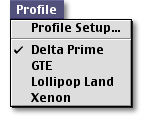 4.3.6.
Profile Menu
4.3.6.
Profile Menu
What is a Profile?
A Profile a set of PPPop preferences. PPPop
stores all of your settings (any options you chose, timer data, Launcher
items, log file name, and so forth) in a preferences file. You can
have several of these preference sets, each with a different name, and
switch between them by selecting its name from the Profile menu.
When would I need Profiles?
-
You use more than one Internet account.
You may want to keep separate timer data, a separate log file, or launch
different scripts or Internet applications from the Launcher for each account.
If you select "Remember Server with Profile" in the Server menu PPPop can
also automatically switch your PPP, TCP/IP, and modem preferences when
you change Profiles.
-
Several family members use the same computer.
Each user can customize PPPop to taste with his own Profile.
-
You use your computer at different locations
and want separate settings or timer data for each. If you use Location
Manager, you can even have it tell PPPop to switch Profiles for you when
you make a Location change.
What about my old PPPop 1.x preference files?
Previous versions of PPPop used "double-clickable"
preference files: you could start PPPop with a given preference set by
double clicking it. That no longer works.
But you can bring those sets into PPPop2 as
Profiles: go to the Profile Setup dialog and click the "Import" button.
Profile Setup...
Brings up the "Profile Setup" dialog:
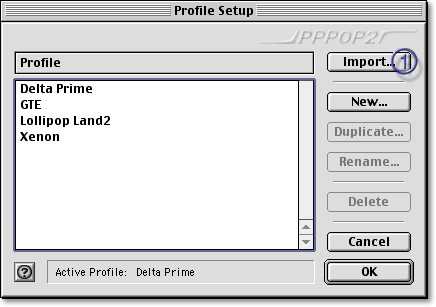
"Import" (1)
will bring in an old PPPop 1.x preference file. This function is
only useful for compatibility with previous versions of PPPop.
To make a Profile active directly from this
dialog, double-click on it in the scrolling list.
Back to Menus
Back to Table of Contents
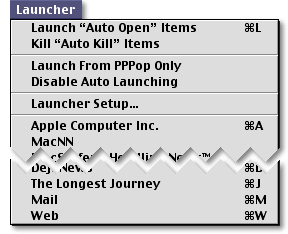 4.3.7.
Launcher Menu
4.3.7.
Launcher Menu
There are many convenient ways to launch frequently
used applications: aliases, palettes, menu additions, popups, and so forth.
But PPPop's Launcher may offer an additional advantage to you: it responds
to the state of your PPP connection. You may have applications or
scripts which you like to start after a connection is open. There
are likely some which you would like to automatically quit when the connection
is closed. You may even want to run scripts or programs right after
a connection closes.
PPPop's Launcher does all of these things.
The Launcher can also help in another situation:
many people have experienced the wonder of catching their Mac dialing up
and connecting all on its own (see the PPPop FAQ).
To solve this problem, it is often enough to change a specific option in
your PPP control panel: in OpenTransport's PPP or Remote Access control
panel it is "Connect automatically when starting TCP/IP applications",
in MacPPP 2.5 "Disable Auto Connect", and in FreePPP "Allow applications
to open connection". Once you changed that option however, you would
find that applications such as Netscape or NewsWatcher will not be able
to open a connection anymore if you launch them alone. In that case,
PPPop's Launcher can still get you there: it can open a connection and
start the application for you.
In the Launcher Item Editor
you can set items to:
• launch automatically whenever PPPop
opens a connection ("Auto Open" flag)
To temporarily disable items from automatic
launching you have three options:
-
Check "Disable Auto Launching" in the Launcher
menu.
-
Hold down the Shift key when you click on PPPop's
connection button.
-
Use the AppleScript command: "set launch
switch to false".
• launch automatically whenever PPPop
closes a connection ("Auto Close" flag)
Some software, such as Daemonkiller,
should run at this time.
.
• be killed whenever PPPop closes a connection
("Auto Kill" flag)
This is a handy way to quit any application
which you do not need anymore once you have closed the connection, e.g.
NotifyMail or NCSA Telnet.
Launch "Auto Open" Items
Launches all of the Launcher items which have
been set to "Auto Open". It enables you to launch a suite of applications
manually with one command.
"Launch 'Auto Open' Items" does not open
a PPP connection, although some of the applications you launch may try
to do so.
To reduce your time online, you could use
this feature to start all your regularly used Internet programs with one
keystroke before opening a connection.
Kill "Auto Kill" Items
Quits all of the Launcher items which have been
selected for "Auto Kill".
Disable Auto Launching
When selected PPPop ignores all "Auto Open",
"Auto Kill", and "Auto Close" settings. At that point you can still
manually start and quit these Launcher items with "Launch 'Auto Open' Items"
and "Kill 'Auto Kill' Items".
"Disable Auto Launching" does not affect
the individual start of Launcher items, you can still manually start them
as usual via their keyboard shortcuts or by selecting them from the Launcher
menu.
Launch From PPPop Only
When a connection is opened or closed from another
application, PPPop will not operate its Launcher. This has the same
effect as "Disable Auto Launching" unless you are opening or closing a
PPP connection from within PPPop.
Launcher Setup...
Brings up the "Launcher Setup" dialog for setting
up Launcher items:
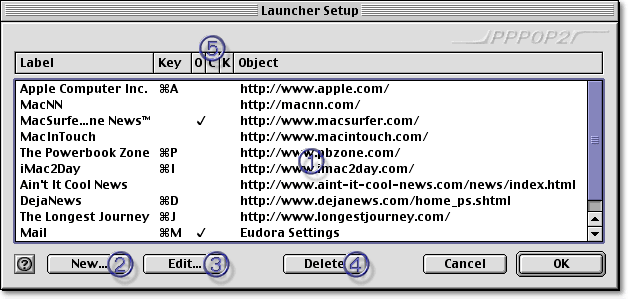
The Launcher Setup can hold up to 200 items
(1). Each line represents one
Launcher item.
New (2),
Edit (3), and Delete (4)
act on the highlighted line in the list. A New item will enter the
list immediately below the currently highlighted item.
Arrow keys (up, down, Command-up, Command-down)
will scroll the list.
You can check the "Auto Open", "Auto Close",
and "Auto Kill" flags (5) directly
on the list with a mouse-click in the desired line and column.
Launcher Example:
In above picture the last item in the list
(with the label "Mail") will do the following:
When PPPop is the active application, pressing
Command-M will open a connection, then launch the Eudora email program
by starting its settings file, and bring it to the front.
Since this Launcher item also has the "Auto
Open" flag checked, the Eudora program will be launched whenever any PPP
connection is opened - not just when Command-M is pressed.
To take this example further, you could write
a little AppleScript that launches Eudora and tells it to get your email
right away:
tell application "Finder"
to open "Hard Disk:Eudora:Eudora Settings" as alias -- absolute
path
tell application "Eudora"
connect with checking and sending
-- check for mail, and send any queued messages
end tell
Save this script as an application (e.g. "Get
Mail"), and set it up as an object to launch.
By clicking "New", or by
selecting a Launcher item and clicking "Edit", or by double-clicking any
Launcher item the "Launcher Item Editor" is brought up:
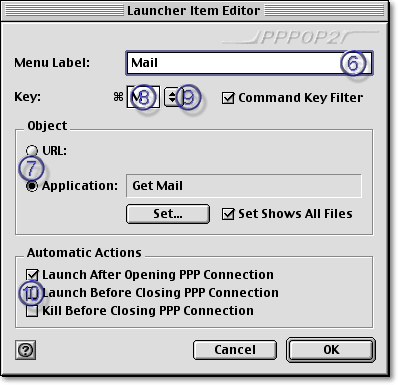
Required Items
• Menu Label (6):
this is the name of the Launcher item and the name you will see in PPPop's
Launcher menu.
• Object (7):
either a URL or an application, a script, preferences file, or other file.
Optional Items
• Keyboard shortcut (8).
As an aid to finding a valid and unused command key, check the Command
Key Filter, or use the popup menu to select a key (9).
If the letters in the popup menu do not make sense on your non-US keyboard,
uncheck the Command Key Filter and type the key you wish to use into the
edit field.
• Automatic Actions (10):
"Auto Open", "Auto Close", and "Auto Kill".
Tip: To conveniently
launch applications and URLs from PPPop use a utility such as UltraLaunch
to set a "hot key" for PPPop. You can then navigate with just the
keyboard: press the hot key to bring PPPop to the front and within PPPop
start any Launcher item with the command key you assigned to it.
Back to Table of Contents
4.4.
Keyboard Shortcuts
Starting up PPPop
• Hold down the Shift key to temporarily
disable "Open Connection on Startup" from the Special menu.
Button Window
• [return] or [enter]: same as clicking
on the button.
• Shift-click: temporarily disable
auto-launching or auto-killing.
• Command-click or Command-enter:
open Launcher Setup dialog.
• Command-drag: move the Button window.
If you select "Auto Position Timer" from the Timer menu, then the Timer
window will follow along, positioned just below the Button window.
Timer Window
• [tab], [Shift-tab], [space] or clicking
in the Timer window will cycle the timer display through daily, session,
and cumulative time.
• Command-click: open the Timer Setup
dialog.
• Command-drag: move the Timer window.
Launcher Menu
• Shift-select: start the Launcher
item without opening a PPP connection.
• Shift-Command-[key]: start the Launcher
item via command key equivalent without opening a PPP connection.
Connection Status Window
• "s" or "i": show or hide the Connection
Status Window.
Dialogs
• [return] or [enter]: same as clicking
OK button.
• Command-. [Command-period] or ESC:
same as clicking Cancel button.
Note: If some
dialogs are too large on your screen to show the OK or Cancel
buttons, operate the dialog with these keyboard shortcuts.
Balloon Help
• Help key (on extended keyboards):
turn balloon help on and off.
Back to Table of Contents
4.5
Scripting PPPop
When you start PPPop from a script, you can tell
it to "run" or to "launch".
PPPop2 cannot be launched from one of its
preferences files.
Scripts may not work correctly if other versions
of PPPop are on the same disk. If you notice any problems, remove
all other versions of PPPop.
AppleScript Dictionary
auto launch -- launch all "Auto Open"
items in the Launcher Menu
auto kill -- kill all "Auto Kill"
items in the Launcher Menu
change config -- notify PPPop that
a PPPop configuration was changed
connect -- no parameters
disconnect -- no parameters
quit
get/set to:
• Boolean (true/false):
blastoff -- open a PPP connection
when PPPop is started
boomerang -- after PPPop opens or
closes a connection it switches back to the previously used application
button title bar -- button with
drag strip
exclusive launching -- enable auto
launching of applications only when PPPop itself opens or closes a connection
fast quit -- on Quit, PPPop will
not care if a PPP connection is still open
finder -- PPPop returns to the Finder
after opening or closing a connection
launcher switch -- enable auto launching
of applications
logging -- PPPop logging function
monthly time reset -- reset total
time monthly
PPP up -- get PPP connection status;
read only
Example:
if PPP up then --
returns true or false
remember server -- on startup or Profile
switch, select last server used by PPPop
round up -- when connection closes,
round session time up to the value set in Timer Setup
safety save -- automatically save
timer data to disk once per minute
show timer -- timer visible or not
verbose -- show modal connection
dialogs (OT/PPP only)
warning alert -- post a notification
alert when time limit is reached
warning cut -- cut the connection
when the time limit is reached
warning sound -- play a sound when
a connection time limit is reached
• numeric:
daily limit -- daily time to trigger
warning, in seconds
daily time -- daily time in seconds
reset day -- day of month to auto
reset cumulative timer; 1-31 please
session limit -- session time to
trigger warning, in seconds
session time -- session time in
seconds
total limit -- total time to trigger
warning, in seconds
total time -- total time in seconds
Example:
set total time to (2*3600 +
40*60 + 11) -- sets time to 2h40m11s
• enumerated:
-
button size (big, small, tiny) -- PPPop
operator button size
-
display time (session, daily, total) --
which time is displayed
-
Example:
-
set show time to daily --
timer shows daily time
-
show timer (always, sometimes, never) --
always/only when connected/never
-
sound (all, off, clicks) -- all sounds,
no sounds (except alerts), button clicks only
• string:
-
IP address -- current IP address, valid
only when connected; read only
-
Modem -- active modem configuration
name (OT/PPP and Remote Access only)
-
profile -- active PPPop Profile name
-
server -- active PPP server name
-
Example:
-
set server to "Delta Prime"
-- alters active configuration in PPP Prefs
-
TCPIP -- active TCP/IP configuration
name
Back to Table of Contents
4.6.
About Internet Config
Note:
Mac OS 8.5 comes with Apple's own version of Internet Config 2.0.
You do not need to install it with OS 8.5. The Internet Setup Assistant
will initialize it for you.
Internet Config 2.0 is a system for storing your
Internet preferences in a form accessible to any application which needs
them. PPPop uses Internet Config to launch URLs by, for example,
opening your web browser of choice and directing it to a specific web page,
or accessing a favorite ftp site. Eudora, NewsWatcher, Netscape,
and Internet Explorer are other applications which use the Internet Config
database.
Internet Config 2.0 comes with a Control Strip
module and a Location Manager module. These can make it very easy
to use more than one dialup account.
Using Internet Config with PPPop
Run the Internet Config 2.0 application.
If it asks you if you want to install the Internet Config Extension, say
that you do. Click on each button in the Main window in turn, entering
appropriate preferences. If you don't understand an item, turn on
Balloon Help. Finally, Save your changes and Quit.
Note:
If you use Mac OS 8.5 use the new "Internet" control panel to make these
changes. This is Apple's own version of Internet Config 2.0.
It is important to realize that you don't have
to set every preference. For example, if you don't use WAIS, there's
no need to set your WAIS Gateway preference.
See Internet Config 2.0 "User Documentation"
for more information.
Back to Table of Contents
5. Troubles?
Questions?
-
Why doesn't PPPop work?
-
What does "PPP not found.
I'm quitting." mean?
-
I can't connect/disconnect
with PPPop.
-
Why does my modem dial
up and connect all by itself as if possessed?
-
Why can't I cancel when
OT/PPP is connecting?
-
Is PPPop obsolete now that
I use FreePPP?
-
How do I change the sounds?
-
How about some more complex
logging options?
-
I registered an older
version of PPPop. My password doesn't work anymore.
-
How does PPPop work?
-
PPPop2 is in my Startup Items folder and it crashes!
-
PPPop2 crashes when I click "Register" and when I open the Help dialog.
Why doesn't PPPop work?
PPPop is just an application. It does not
install any extension, configure, or patch anything. But you must
have a PPP driver - MacPPP, FreePPP,
Remote Access, or OT/PPP - up and running before you can use PPPop.
If you are having trouble with this step, I strongly recommend reading
the FreePPP
2.5 FAQ.
What does "PPP not found.
I'm quitting." mean?
When PPPop runs, it checks to see which PPP driver
is installed. If it doesn't find a PPP driver it knows about, it
puts up this message. If you have Open Transport TCP/IP, make sure
you have at least one TCP/IP configuration set up and make sure it uses
one of the PPP drivers supported by PPPop.
I can't connect/disconnect
with PPPop.
PPPop uses the same code as FreePPP 1.0.5 to
open and close a PPP connection with MacPPP or FreePPP. If you cannot
connect/disconnect using Config PPP (from FreePPP 1.0.5) or FreePPP Setup
(from FreePPP 2.5+), then it won't work with PPPop either. If it
does work with Config PPP, it should also work with PPPop. Please
let me know if this is not the case.
PPPop may not be compatible with MacPPP
2.2.0 or MacPPP 2.2.1SD; some users have no problems, others do.
PPPop is not compatible with commercial PPP
software such as InterSLIP or NTS PPP. And PPPop is not compatible
with FreePPP versions between 2.5.1 and 2.5.5.
Why does my modem dial
up and connect all by itself, as if possessed?
With or without PPPop, many people have had the
problem that their machine connects by itself, often in the middle of the
night, for no apparent reason. There is more information about this
in the FreePPP
2.5 FAQ.
Here are some actions to try:
-
If you are using MacTCP, install FreePPP 2.5v3.
I am told there is a bug in MacTCP which this version can patch.
-
If you are using Open Transport, open the TCP/IP
control panel Options and select "Load only when needed". (You need
to set your User Mode in the Edit menu to at least "Advanced" to get to
the TCP/IP Options.)
-
In OpenTransport's PPP or Remote Access control
panel disable "Connect automatically when starting TCP/IP applications",
in MacPPP 2.5 "Auto Connect", and in FreePPP "Allow applications to open
connection".
-
Isolate an extension which might be causing the
problem, especially something having to do with a network. As a last
resort, try starting up without extensions and adding them back in a group
at a time.
Why can't I cancel when
OT/PPP is connecting?
Clicking PPPop's button while a connection is
being opened is supposed to cancel the process and return the connection
to idle. Some people found that when they did this, either nothing
happened, or PPP ended up in limbo.
The problem turned out to be in the modem
scripts. The proper hangup sequence had been commented out with "!"
marks. It was supposed to send the "+++" escape code to get the modem
into command mode rather than using hardware signalling via DTR.
Simply removing the "!" marks before these 4 commands solved the problem.
Bad Modem Script Example:
@LABEL 92
! Escape from data to command mode
!matchclr
!matchstr 1 96 "OK\13\10"
!write "+++"
!matchread 20
!
The modem CCL scripts can be read and edited
with BBEdit or another text editor. Make sure they are saved with
their original file type 'mlts' and creator 'slnk'. While you are
at it, set the serial port speed to 115,000 for 28.8 or faster modems -
if your Mac will support it.
Is PPPop obsolete now that
I use FreePPP?
FreePPP comes with a control strip module and
a menu bar extension. It has a session timer and can launch an application
when a connection opens. It is certainly more convenient to use FreePPP
than MacPPP.
But I believe most of you will find that
PPPop still has a purpose in life:
• The control strip is not so handy
for people who don't use its modules frequently, or who don't have a lot
of screen space.
.
• The menu bar can get pretty cramped
with application menu, help menu, keyboard menu, desktop printer menu,
time, battery status, Now Menus, Microsoft Office Manager and what-all.
.
• PPPop's window can be very small,
can be positioned anywhere, and gives you a visible reminder for example
that you are daydreaming while composing email online.
.
• PPPop gives you a separate Timer
window which you can size and position anywhere. It has not only
a session timer but also a daily and total timer with warning limits.
.
• PPPop can not only launch an application
or script automatically, it also allows you to launch them manually, launch
URLs, and it can quit your applications when you go off line as
well as clean up any automatic software you have running.
.
• Some users don't care about any
of this, but they really like the sound playing capabilities.
.
• PPPop is scriptable.
.
• You don't have to use either
FreePPP's add-ons or PPPop: you can use them all at the same time
if you want to.
How do I change the sounds?
The sounds distributed with PPPop are from Clixsounds.
They have a large collection of sounds and I'm sure you will like some.
Another favorite way to get sounds is to
extract them from games. There are several good shareware sound editors
which can do this. The hard way is to open the game with ResEdit,
copy a 'snd ' resource, and save it as a file of type 'sfil'.
You can also capture sounds from CD's, and,
of course, record some with your microphone.
To change the sounds PPPop uses, just go to
"Sound Setup..." in the Special menu.
How about some
more complex logging options?
This version of PPPop has an option to round
up the connection time to a settable number of minutes.
Many people want to compute exact connection
and telephone charges. These are often rather complicated because
they depend upon time of day, time connected, server used, country of residence,
holiday or weekend, and so forth. I recommend that you look at Eric
Preston's Internet Logger. (The current version will be on an Info-Mac
mirror.)
I registered an older
version of PPPop. My password doesn't work anymore.
PPPop v1.5 was the first version to require a
password to register. With v1.6 the password scheme changed.
Still, anyone who registered v1.4-1.5 is entitled to a free upgrade to
v1.6. Please email me if you need your new password.
PPPop2 is a new program and requires its own
new password. Previously registered users may upgrade for a small
fee. They will receive a special upgrade password when they re-register.
Note:
If you have changed your email address, please include your old registration
confirmation from Kagi when you contact me, if possible.
How does PPPop work?
Applications which open a connection generally
do so by requesting network services. PPPop, however, operates more
like a control panel for your PPP software. It talks directly to
the PPP driver via a programmer's interface. When your PPP software
signals that a connection has opened or closed, PPPop reacts. If
PPP does not know what the state of a connection is, neither does PPPop.
PPPop also reads the preferences file maintained
by your PPP software to get a list of your configurations. If you
change the configuration via PPPop's Server menu, then PPPop will alter
this preferences file.
PPPop2 is in my Startup Items folder and it crashes!
Some users have reported that when they put PPPop2 (or its alias) in their Startup Items folder, PPPop2 crashes. It seems this can happen when there are other items in the Startup which launch after PPPop2. I am still looking for the cause of this problem.
These users have been able to work around the problem by renaming PPPop2 (or its alias) to "~PPPop2". As Startup items are launched in alphabetical order, this should force PPPop2 to launch last.
PPPop2 crashes when I click "Register" and when I open the Help dialog.
Some users have reported that PPPop2 crashes when they open the Register or Help dialogs. So far, all of these users have been running the Appearance 1.0 extension on their systems. It is buggy. Apple has replaced it with Appearance 1.0.3.
Appearance 1.0.3 can be obtained from Apple.
Back to Table of Contents
6. Registering
PPPop2
PPPop is Shareware. It is fully functional
as distributed, but it does put up a shareware notice. When you register,
you will receive a password to disable this shareware notice.
Why pay? If you use the program and
you like it, think of it as a tip for good service.
Prices:
Single-user
license: US$20
Covers use by one person on one computer
at a time. You do not need a separate registration for each computer
you own.
Single-user
upgrade: US$10
Upgrade from any previously registered version
of PPPop to PPPop2.
Site
license: US$99
Covers all users at your site (building -
computer lab, university, or small company).
World-wide
license: US$2000
Covers all users within your organization
on the entire planet and in near Earth orbit.
ISP
license: by arrangement
Non-exclusive license for an ISP to distribute
unlimited copies of PPPop with their Internet connection kit. Includes
removal of shareware notices and minor customization, e.g. with company
colors.
You may distribute this program intact
and unmodified along with the Register application and full documentation,
but you may not charge for this program!
How to register
The easiest way is to Register
PPPop Online via Kagi Shareware.
or
If you prefer to deal direct, you can mail
US$ in cash or check directly to the author:
.
Rob Friefeld
4607 Colorado Street
Long Beach, CA 90814
U.S.A.
.
or
 Use
"Register PPPop", the registration application distributed with PPPop.
It will present you with a simple screen to produce a registration form
for you. You can email, fax, or postal-mail the form to Kagi Shareware,
my collection agent.
Use
"Register PPPop", the registration application distributed with PPPop.
It will present you with a simple screen to produce a registration form
for you. You can email, fax, or postal-mail the form to Kagi Shareware,
my collection agent.
If you don't have "Register PPPop", then you
have an incomplete distribution archive of PPPop. Other things may
be missing as well. In that case I recommend that you download the
full current version from the PPPop
Web Page.
Anti-litigation Statement
PPPop is distributed because it may be useful.
It is not warranted to do anything, nor to be free of bugs. If PPPop
causes you grave physical, financial, or emotional harm - you have my sympathy.
Beyond that, the author disclaims any liability for any kind of damages
whatsoever resulting from the use of this program. You use this software
at your own risk. Do not use PPPop if you
do not agree to these conditions.
PPPop2 is © 1998 by Rob Friefeld.
All rights reserved. PPPop may not be distributed for profit or as
part of any commercial offering without first obtaining the express written
consent of the author.
Attributions
The code which controls MacPPP was derived from
MacPPP 2.0.1, ©1993 Merit Network, Inc. and The University of Michigan.
Control of FreePPP 2.6 is done via Steve Dagley's FreePPP Public Interface.
Previous versions of PPPop have been localized.
Guy
Brand has made a French localization of PPPop.
Haruka
Ishi has made the Japanese localization and contributed a great deal
to the design of PPPop.
June-Hao
Hou has made a Traditional Chinese localization.
Frank
Meijer has made a Dutch localization.
Localization of this version of PPPop is
currently underway.
The graphical design of PPPop is mostly the
work of Andreas Bauer, co-developer
of PPPop.
Back to Table of Contents
7. Contact
Information
Rob Friefeld, 4607 Colorado Street, Long Beach,
CA 90814
Email 1: frie@gte.net
Email 2: rob@kagi.com
 WorldWideWeb:
PPPop Web Page
WorldWideWeb:
PPPop Web Page
 Table
of Contents
Table
of Contents Table
of Contents
Table
of Contents When
you use PPPop, you don't need to use another control panel to open or close
a connection. Just click on PPPop's button. The arrow on the
button shows the current state of PPP: up or down.
When
you use PPPop, you don't need to use another control panel to open or close
a connection. Just click on PPPop's button. The arrow on the
button shows the current state of PPP: up or down.
 PPPop
is aware of Mac OS 8.5 Appearance Themes as well as Kaleidoscope Color
Schemes.
PPPop
is aware of Mac OS 8.5 Appearance Themes as well as Kaleidoscope Color
Schemes.
 The
first thing to do after launching PPPop is to move the Button window to
a good spot on your screen. You may also wish to change its size
and eliminate the window's title bar. (See Special menu.)
Once you eliminate the title bar, you can still move the window by holding
down the Command key while dragging it. If you make the window "float",
it will always be visible on top of other program's windows.
The
first thing to do after launching PPPop is to move the Button window to
a good spot on your screen. You may also wish to change its size
and eliminate the window's title bar. (See Special menu.)
Once you eliminate the title bar, you can still move the window by holding
down the Command key while dragging it. If you make the window "float",
it will always be visible on top of other program's windows.
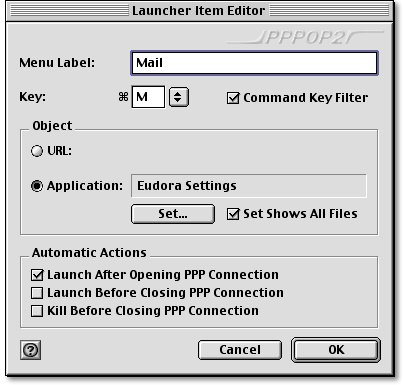
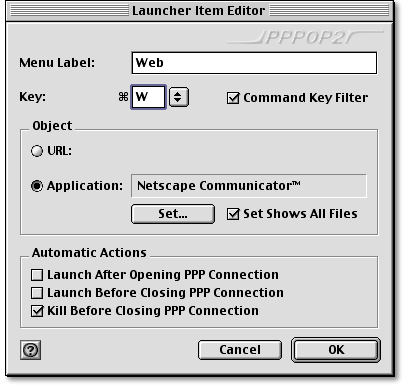
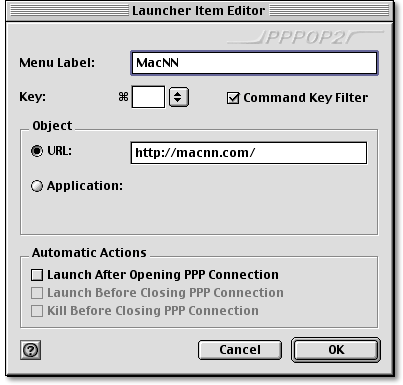

 4.3.1.
File Menu
4.3.1.
File Menu 4.3.3.
Special Menu
4.3.3.
Special Menu Select a PPP operator button size:
Select a PPP operator button size:
 With OT/PPP, a dialing icon appears when you click the button to open a
connection. You can click the button to cancel the process.
After that it may take a few seconds for OT/PPP to reset before you can
try again.
With OT/PPP, a dialing icon appears when you click the button to open a
connection. You can click the button to cancel the process.
After that it may take a few seconds for OT/PPP to reset before you can
try again.
 When
PPPop becomes a background application, the button icon gets a distinctive
dimmed/recessed appearance. This should allow you to quickly recognize
if PPPop is the active application.
When
PPPop becomes a background application, the button icon gets a distinctive
dimmed/recessed appearance. This should allow you to quickly recognize
if PPPop is the active application.

 4.3.4.
Timer Menu
4.3.4.
Timer Menu
 4.3.5.
Server Menu
4.3.5.
Server Menu 4.3.6.
Profile Menu
4.3.6.
Profile Menu
 4.3.7.
Launcher Menu
4.3.7.
Launcher Menu

![]() Use
"Register PPPop", the registration application distributed with PPPop.
It will present you with a simple screen to produce a registration form
for you. You can email, fax, or postal-mail the form to Kagi Shareware,
my collection agent.
Use
"Register PPPop", the registration application distributed with PPPop.
It will present you with a simple screen to produce a registration form
for you. You can email, fax, or postal-mail the form to Kagi Shareware,
my collection agent.
![]() WorldWideWeb:
PPPop Web Page
WorldWideWeb:
PPPop Web Page